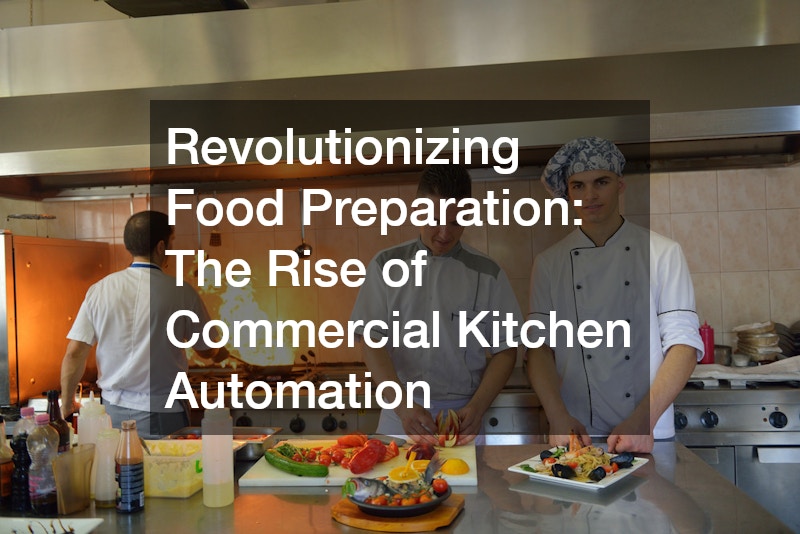In recent years, the food industry has seen a significant transformation driven by technological advancements. One of the most impactful changes has been the rise of commercial kitchen automation. This trend revolutionizes food preparation, making it more efficient, consistent, and cost-effective. For restaurants, hotels, and other food service providers, embracing commercial kitchen automation is no longer a luxury but a necessity to stay competitive in a fast-paced market.
The Need for Automation in Commercial Kitchens
The food service industry faces numerous challenges, including labor shortages, rising costs, and the need for consistency in food quality. Commercial kitchen automation addresses these issues by streamlining operations, reducing the reliance on human labor, and ensuring uniformity in food preparation.
Automated systems can handle repetitive tasks such as chopping, mixing, and cooking, allowing chefs to focus on more creative aspects of their work.
Advantages of Commercial Kitchen Automation
Increased Efficiency: Automated kitchen equipment can perform tasks faster than human workers, significantly boosting productivity. For instance, automated fryers and ovens can cook food to perfection without constant supervision, freeing up staff to handle other responsibilities. This leads to faster service times and the ability to serve more customers.
Consistency and Quality: Automation ensures that every dish is prepared to the same standard, eliminating the variations that can occur with human error. This consistency is crucial for maintaining a restaurant’s reputation and ensuring customer satisfaction. Commercial kitchen equipment, such as automated slicers and dicing machines, can produce uniform cuts, enhancing the visual appeal and taste of dishes.
Cost Savings: While the initial investment in commercial kitchen automation can be high, the long-term savings are substantial. Automation reduces labor costs by minimizing the need for manual labor, decreases food waste through precise portion control, and lowers energy consumption with efficient cooking processes. Over time, these savings can significantly offset the upfront costs of automation.
Improved Safety and Hygiene: Automated systems reduce the risk of accidents and injuries in the kitchen by handling dangerous tasks such as slicing and frying. They also contribute to better hygiene by minimizing human contact with food, reducing the chances of contamination. Commercial kitchen equipment designed with easy-to-clean features further enhances sanitation.
Key Technologies in Commercial Kitchen Automation
Several innovative technologies are driving the adoption of commercial kitchen automation:
Robotic Cooking Systems: These systems can prepare entire meals autonomously, from chopping ingredients to plating dishes. Robotic arms and advanced software enable precise control over cooking processes, ensuring consistent results.
Smart Ovens and Fryers: Equipped with sensors and connected to the Internet of Things (IoT), these appliances can adjust cooking times and temperatures based on the type and quantity of food. This ensures optimal cooking conditions and reduces energy consumption.
Automated Beverage Dispensers: These machines can mix and serve drinks consistently, reducing wait times and enhancing customer experience. They are particularly useful in high-traffic areas like fast-food restaurants and cafes.
Inventory Management Systems: Automated systems can track inventory levels in real-time, alert staff when supplies are low, and even place orders with suppliers. This reduces the risk of running out of essential ingredients and helps manage costs more effectively.
The Future of Commercial Kitchen Automation
The future of commercial kitchen automation looks promising, with continuous advancements in technology and increasing adoption across the food service industry. Artificial intelligence (AI) and machine learning will significantly enhance automation capabilities, allowing systems to learn from past performance and improve over time.
In addition, integrating automation with other aspects of restaurant management, such as ordering and delivery systems, will create a seamless and efficient operation. Customers can expect faster service, consistent food quality, and a more enjoyable dining experience.
Embracing Commercial Kitchen Automation
Investing in commercial kitchen automation is a strategic move for food service providers looking to stay competitive. It not only addresses current challenges but also prepares businesses for future demands. By embracing automation, restaurants can improve efficiency, reduce costs, and maintain high food quality and safety standards.
Conclusion
The rise of commercial kitchen automation is transforming the food service industry. With its numerous advantages, including increased efficiency, consistency, cost savings, and improved safety, automation is becoming an essential component of modern commercial kitchens. As technology advances, the potential for further innovation in commercial kitchen equipment is vast, promising a future where food preparation is more streamlined and reliable than ever before. For businesses in the food industry, now is the time to explore the possibilities of commercial kitchen automation and revolutionize their operations.
.

